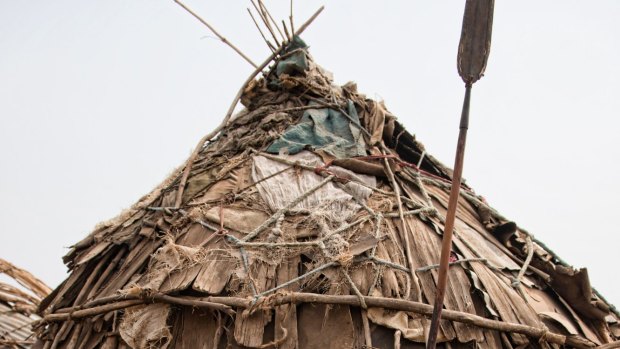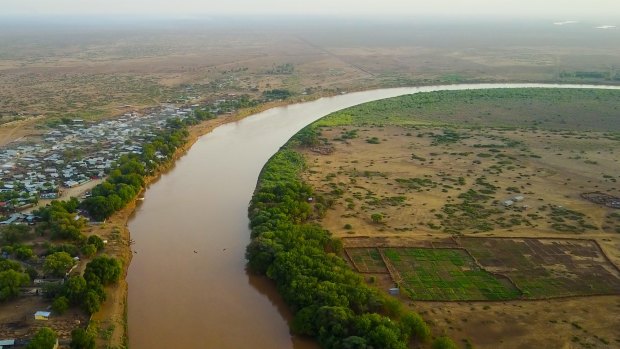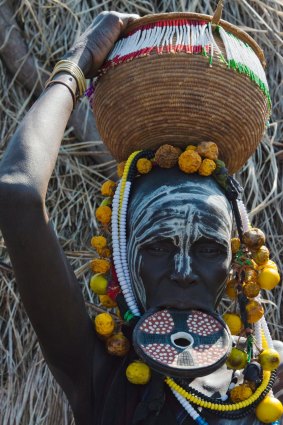This was published 7 years ago
Staying with local tribes in South Omo Valley, Ethiopia
By Sue Williams

Two young women from the Hamar tribe, in the Turmi area of the isolated South Omo Valley.Credit: Alamy
A blood-curdling shriek rends the heavy night air of a remote African village.
I sit up in alarm on my dried cow hide laid out on the red dust. There's a millisecond of silence … and then an absolute cacophony of cries, stamping, mewing and bleating.
It rises steadily to a crescendo before the blaring honking of a group of donkeys, who must have been the ones to start everything off, drowns out all the other animals.

Ol Dassanech woman in front of her hut.Credit: Alamy
The chief, lying two metres away on his cow skin between the huts of his various wives and children, stirs and shouts something, and gradually the noise starts to subside. The donkeys settle down, the cattle shift into a more comfortable position, the goats nestle together and the lone baby lamb who wandered in as an orphan the previous day, suckles again on a goat he thinks is its mum.
All seems well on this little encampment in south-western Ethiopia on the Horn of Africa but my heart is beating so wildly out of my chest, it takes me another hour to calm down enough to sleep.
I'd been loving lying out under the bright night stars but, as the temperature starts to drop, I move into a little tent that's been thoughtfully put up for me by the neat tree-branch-and-animal-dung circular huts.

The Omo river.Credit: Alamy
By the time the sun rises the next morning, I've already watched the women set off to the nearest well with their plastic containers, the kids check on the animals, the chief start to dig a pit and his mother begin to ground sorghum to make him beer.
It's extraordinary to have the chance to live among one of the most traditional tribes on the continent, the pastoralist Hamar in the Turmi area of the isolated South Omo Valley. And they, as it turns out, are as fascinated with me as I am with them.
I touch the elaborate red-ochred hairstyles of the women, as they pat my blonde hair. They finger my clothes as I admire their copper necklaces – which delineate their importance as the number one, two or three bride – beads and goat skins. We sit in one of the huts together as they roast coffee beans over a blazing fire then hand around a great wooden flagon of coffee to share.

Mursi tribe people with lip plate.Credit: Alamy
I play clapping games with the kids, quite unable to grasp the rudimentary rules. I attempt to help them milk the goats and fail abysmally. And to their squeals of delight I try to lift one of the containers of water the women have carried five kilometres on their backs – and can't even raise it off the ground.
The whole experience is incredibly precious and, in a country with more than 80 ethnic groups, this area is teeming with amazing sights. Another day, one group of Hamar held their bull-jumping ceremony, where a young man proves his manhood by running across the backs of a row of bulls, as part of an ancient initiation rite to show he is ready to marry and raise a family.
Female members of the tribe, meanwhile, watch and dance to support the boy undergoing the trial. At one point too they volunteer to be whipped with tree branches to demonstrate their devotion. It's a confronting ceremony for outsiders but the women involved proudly display their scars afterwards as proof of their courage and love.
The next day, I travel down to the Omo River, cross the muddy flow in a hollowed-out log poled along by a boatman that's only just wide enough to accommodate my girth, and nearly upturn it as I clamber out – much to the thrill of the crowd watching on the bank.
Then I walk to Omorate village, close to the Kenyan border just north of Lake Turkana, home of the agro-pastoralist Dassanach tribe who live in dome-shaped huts fashioned from branches and hides.
Children jostle and compete to hold my hand as I wander around the village and a group of women shyly begin to dance as I advance. "Welcome!" an old lady calls to me in her language. "You must dance too!"
But the third tribal people I encounter at their village 60 kilometres from the main town of the valley, Jinka, are even more spectacular. The appearance of the Mursi is simply startling.
Most are covered with tattoos and ornamental scars, have intricate patterns painted over their entire, often naked, bodies and wear elaborate headdresses made from skins, bones, antlers and local dried fruits and berries. The women, moreover, have huge ceramic plates inserted into their lower lip, in which a slit was cut as children.
It's not known whether this dates from a time they did it to make themselves more attractive – or less attractive for when the slave traders arrived on their shores.
But, either way, for Western visitors, they're welcoming, engaging and enormously good-humoured, and happy to pose for photographs for a small fee which seems a perfectly valid exchange.
And for us, it's a rare and treasured glimpse into an Africa that might not, with better infrastructure, global communications and increasing tourism, exist for too much longer.
TRIP NOTES
MORE
FLY
Several airlines, including Emirates and Ethiopian Airlines, fly into Addis Ababa. Ethiopian Airlines also have an internal flight three times a week to Jinka in the South Omo Valley. See ethiopianairlines.com
STAY
Eyob Hotel, Jinka, is one of the best hotels in the area, with a pleasant outdoor bar and restaurant on site and good Wi-Fi for about $25 a twin. Ph +2519 3006 9577. Buska Lodge, Turmi, is a good option in the town with a good restaurant, for $120 a double. Ph +2511 1156 7838. See buskalodge.com. For camping with the Hamar people see below.
TOUR
Several travel companies organise tours of the South Omo Valley. I went with the local outfit Omo Valley Tours which offers stays with tribes. Ph +2519 1260 8430. See www.omovalleytours.com Other companies touring the area include Peregrine, Intrepid and World Expeditions.
Sue Williams travelled at her own expense.
Sign up for the Traveller Deals newsletter
Get exclusive travel deals delivered straight to your inbox. Sign up now.